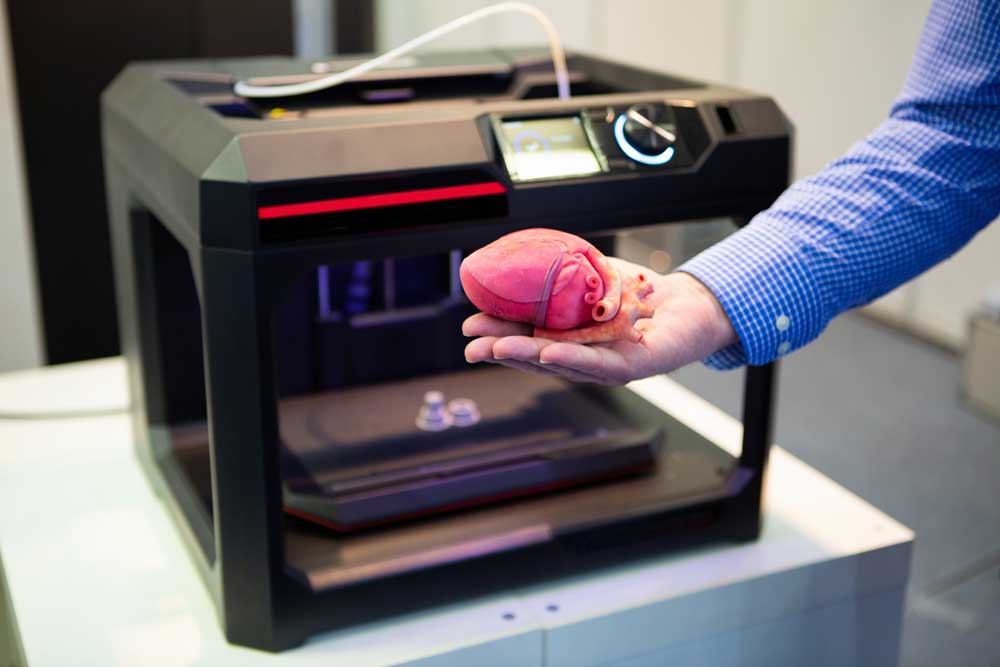The idea of 3D printed technology has been around for a while, but it has received attention only in recent years as a biomedical tool that can aid healthcare. In 1999, the first 3D-printed bladder was transplanted into a human at the Wake Forest Institute for Regenerative Medicine. It was covered with his own cells and still working, when we last checked. Since then, there have been other breakthroughs such as 3D prosthetic limbs.
What Are 3D Printed Organs?
As the name suggests, 3D Printed organs are replicas of the real things, except they’re made in a lab. The process is called additive manufacturing or the use of software to create a 3D physical object. They’re made of biological materials such as ‘bio-ink’ or cultured cells that are protected by the addition of biopolymer hydrogels. This means, the patient’s cells must be harvested to replicate an organ and the bio-ink is specific only to that particular patient.
How Are 3D Organs Printed?
Images of the patient’s organs are first obtained through diagnostic tools such as ultrasounds, MRIs (Magnetic Resonance Imaging) and CT (Computerised Tomography) scans. It is vital that the 3D organs are absolutely accurate. The digital images from various scans are used, followed by 3D modelling. The modelling software helps create the details, layers and dimensions required. The initial version usually does not possess any textures or other surface attributes. These are added later to achieve a durable and uniform finish. Since the technique is used to replicate biometric 3D tissues, it can also be called 3D bioprinting.

Can 3D Printing Be Used Specifically For Women’s Health?
According to the journal Science Direct, EBB (Extrusion-based 3D Bioprinting) is the most commonly used bioprinting technology for the female reproductive system. Due to the complexities of the organ system involved, it builds 2D patterns layer by layer to create the right 3D structure.
The journal also states, ‘When constructing complex tissues, regenerative medicine requires precise control of cells and biomaterials, which traditional tissue engineering approaches often cannot achieve due to the difficulty in creating complex geometric shapes and layered tissue structures, which limits the application of regenerative medicine in repairing complex tissues. 3D bioprinting technology addresses this challenge by enabling the integration, arrangement, and combination of cells, ECM, and cytokines in specific configurations, providing precise spatial control of cells and creating suitable microenvironments for cell function. This technology offers tremendous potential for constructing complex tissues and organs. For women with endocrine dysfunction resulting from reproductive organ damage, 3D bioprinting offers a pathway to regenerative medicine. This approach allows the creation of biocompatible, biodegradable, and functional prosthetic tissues or organs, enabling repair or replacement of damaged tissues to restore fertility and ovarian endocrine function.’
Although 3D organ transplants are not yet available, tests were conducted a few years ago in Chicago. A female mouse was able to ovulate with a bioprosthetic ovary, and even give birth to healthy pups and nurse its young ones. The scientists were hopeful that this spelled good news for women who needed a restoration of fertility.
‘What happens with some of our cancer patients is that their ovaries don’t function at a high enough level and they need to use hormone replacement therapies in order to trigger puberty,” Monica Laronda, co-lead author of the research and a former post-doctoral fellow in the Woodruff Lab said in an interview. “The purpose of this scaffold is to recapitulate how an ovary would function. We’re thinking big picture, meaning every stage of the girl’s life, so puberty through adulthood to a natural menopause.”
Can 3D Printing Make Organ Transplants Easier?
Yes and no. Simpler organs like skin and cartilage can be created, as these don’t involve complex structures. Victims of burns, for instance, can benefit from 3D skin bioprinting. 3D organs are also lesser tricky than a donor’s organs because they are customised from the patient’s own cells. The transplant is lesser likely to get rejected, although there is always a small chance it may. 3D printed organs also means you don’t have to wait for an organ donor. However, one also has to be cognizant of the quality of printing materials and bio-ink used, before taking the plunge.
We also have a long way to go before 3D organ printing can provide a surefire alternative for hearts, lungs, or brains. Research is underway, but it is hard to say when there will be a breakthrough. This doesn’t mean that 3D replicas hearts or lungs do not serve any purpose. They can be used for a variety of purposes such as disease modelling and drug testing. Since they mimic the physiology of the actual organ, they can be used by doctors and researchers to understand the body’s response to disease and medication. It can also be a vital tool for drug testing, ensuring safety and efficacy.